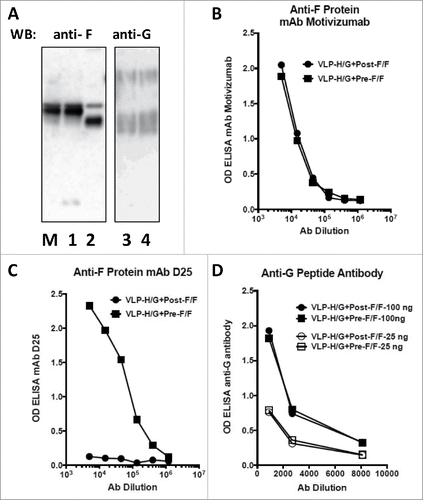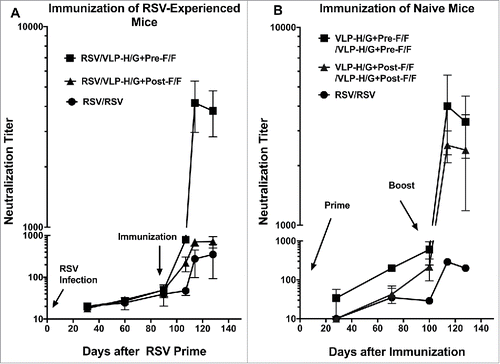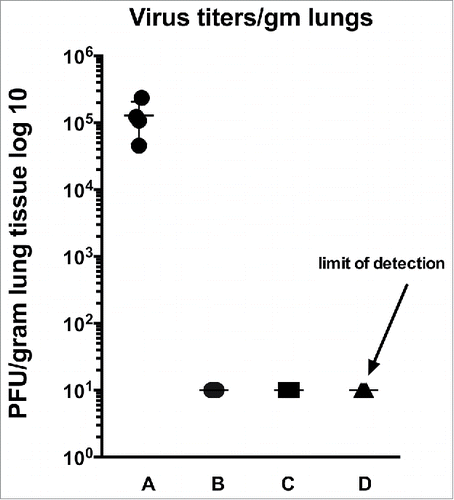Figures & data
Figure 1. Protein content of VLPs. Panel A shows a Western blot of proteins present in stocks of VLP-H/G+Pre-F/F and VLP-H/G+Post-F/F. Proteins (electrophesed in the presence of reducing agent) in a polyacrylamide gel containing duplicate lanes of the proteins in the 2 VLPs were transferred to a membrane. One half was incubated with anti-F antibody (lanes M, 1, 2). The other half was incubated with anti-G antibody (lanes 3, 4). M: marker Pre-F/F protein. Lanes 1, 3: VLP-H/G+Pre-F/F; Lanes 2, 4: VLP-H/G+Post-F/F. The panel shows results of one of 3 separate blots with identical results. Panels B and C show binding of different concentrations of mAb motivizumab (panel B) or mAb D25 (Panel C) to each VLP in an ELISA as described previously.Citation21 Panel D shows binding of an anti-G protein peptide antibody to 2 different concentrations of VLPs (concentrations in ng of F protein). Results were identical in 3 or 4 separate determinations.

Figure 2. Immunization/infection timelines. Top panel shows timing of infection of animals with RSV (day 0) and their subsequent immunization with VLPs (day 95) or a second RSV infection (day 95). Sera were harvested from each animal at times indicated by arrows pointing upwards. Bottom panel shows timing of prime immunization with VLPs or RSV infection of naïve animals (day 0) and the subsequent boost with VLPs or a second RSV infection (day 100). Sera were harvested at times indicated by arrows pointing upward.

Figure 3. Neutralization titers in sera from RSV-experienced or naïve animals. Panel A shows neutralization titers in pooled sera after a single immunization with VLPs of RSV previously infected animals. At day 128, the difference between results of VLP-H/G+Pre-F/F immunization and VLP-H/G+Post-F/F immunization was significant with a p value of 0.0009. The difference between VLP-H/G+Pre-F/F and RSV immunization was significant with a p value of 0.0005. Difference between VLP-H/G+Post-F/F and RSV immunization was not significant. All results are the average of 4 separate determinations with mean and standard deviation shown. Panel B shows neutralization titers in pooled sera after a prime and after a boost of naïve animals with VLPs or RSV. At day 71, p values for the difference between results of immunization with VLP-H/G+Pre-F/F and VLP-H/G+Post-F/F was 0.0005 and for the difference between VLP-H/G+Pre-F/F and RSV was 0.0030. The difference between VLP-H/G+Post-F/F and RSV was not significant. At day 128, the difference between results of VLP-H/G+Pre-F/F immunization and VLP-H/G+Post-F/F immunization was not significant. The p values for difference between VLP-H/G+Pre-F/F and RSV immunization was 0.035 and for the difference between VLP-H/G+Post-F/F and RSV immunization was 0.0012. Results are the average of 3 separate determinations with mean and standard deviation shown.

Figure 4. Total anti-F protein antibody in animal sera. Total anti-F protein antibody was measured in ELISA using as target purified soluble pre-fusion F (panels A and C) or purified soluble post-fusion F protein (panels B and D). Panels A and B show ng/ml of anti-F protein IgG at different time points in RSV-experienced animals. Results are the average of 2 separate determinations. For the pre-F target as well as post-F target the difference at day 128 between RSV/VLP-H/G+Pre-F/F and RSV/VLP-H/G+Post-F/F groups was not significant. For the pre-F target, p value for difference between RSV/VLP-H/G+Pre-F/F and RSV/RSV was 0.030 while the difference between RSV/RSV and RSV/VLP-H/G+Post-F/F immunization was not significant. For the post F target, the p values for differences between RSV/VLP-H/G+Pre-F/F or RSV/VLP-H/G+Post-F/F VLP immunization and RSV/RSV immunization were 0.034 and 0.0011, respectively. Panels C and D show ng/ml of anti-F protein IgG at different time-points in immunized naïve animals. Figure shows results of one of 2 determinations with identical results and replicates results previously reported.Citation21 For the pre-F target or the post-F target the differences in values at day 128 between all groups were not significant.

Figure 5. Total anti-G protein antibody in animal sera. Total anti-G protein IgG was measured in ELISA using as target soluble G protein. Panel A shows ng/ml of anti-G protein IgG at different times in RSV-experienced animals. The results are the average of 4 separate determinations with average and standard deviations shown. At day128, p value for the difference between RSV/VLP-H/G+Pre-F/F and RSV/VLP-H/G+Post-F/F immunization was 0.0057, the p value for the difference between RSV/VLP-H/G+Post-F/F and RSV/RSV was 0.002. The p value for the difference between RSV/VLP-H/G+Pre-F/F and RSV/RSV was 0.0002. Panel B shows ng/ml of anti-G protein IgG in immunized naïve animals. Results are the average of 2 separate determinations with standard deviations shown. At day 128, p values for differences between VLP-H/G+Pre-F/F and VLP-H/G+Post-F/F immunization, for RSV and VLP-H/G+Pre-F/F-VLP immunization, and for RSV and VLP-H/G+Post-F/F immunization were 0.042, 0.019, and 0.055 respectively.

Figure 6. Protection from challenge. Shown are lung titers after challenge of RSV-experienced VLP immunized animals. RSV challenge was 125 d after VLP immunization. A: no RSV prime, no immunization; B: RSV primed, RSV immunized; C: RSV primed, VLP-H-G+Pre-F/F immunized; D: RSV primed, VLP-H/G+Post-F/F immunized. Each group contained 5 animals and titers of each animal are shown in the graph. The p value for the differences between group A and the other groups is 0.0182.

